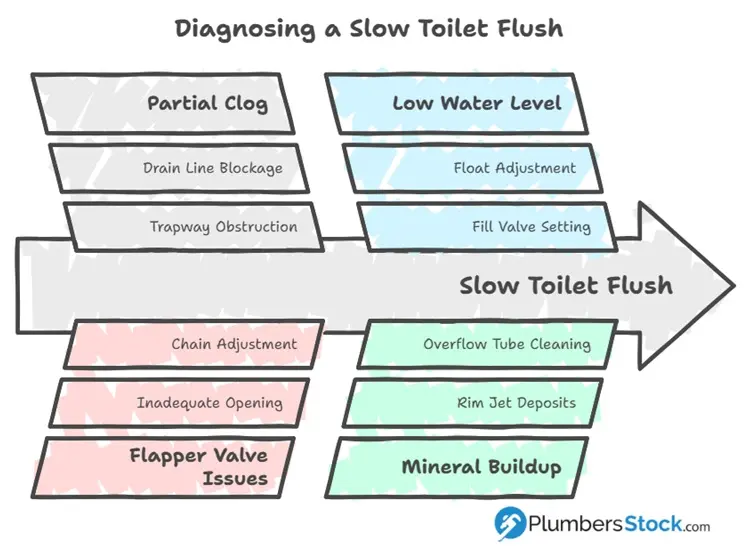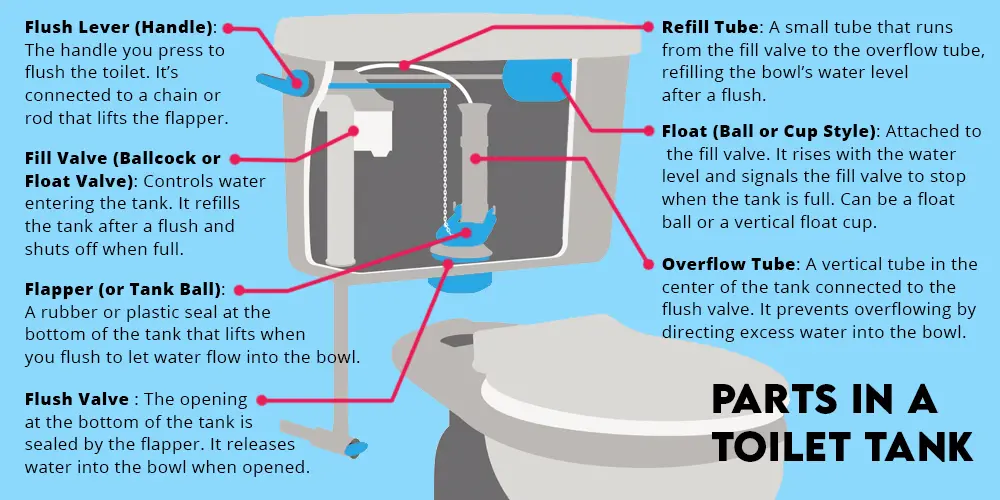 Is your toilet taking too long to flush or fill? These common issues can usually be solved with a few simple adjustments. Here are instructions for both diagnosing and how to fix a slow toilet flush.
Is your toilet taking too long to flush or fill? These common issues can usually be solved with a few simple adjustments. Here are instructions for both diagnosing and how to fix a slow toilet flush.
Toilet is Flushing Slow: Common Causes
- Partial clog in the trap or drain line
- Low water level in the tank
- Mineral buildup in the rim jets
- Flapper is not opening fully
Fixing a Slow Toilet Flush
- Check for a Partial Clog
Pour a bucket of water (about 2 gallons) into the bowl quickly. If it flushes normally, the issue isn’t a clog. If it’s still slow, use a toilet auger to clear the trapway or drain. - Inspect the Flapper Valve
Remove the tank lid and flush the toilet. Watch the flapper—does it open fully and stay open long enough? If not, replace the flapper or adjust the chain for more slack. - Raise the Water Level in the Tank
The water should be about 1 inch below the top of the overflow tube. Adjust the float or fill valve to increase the water level. - Clean the Rim Jets
Use a small mirror to inspect under the toilet rim. If you see mineral deposits, gently clean them using a wire (like a straightened paperclip). You can also pour vinegar into the overflow tube and let it sit for about an hour.
Additional Expert Insight
“Toilet flush performance depends on more than just the amount of water in the tank. Rim jets, siphon jet design, and drain venting all play a role. Even mineral buildup the size of a grain of rice can impact flush efficiency.” – American Standard Plumbing Product Manual

 Frequently Asked Questions About Slow-Flushing Toilets
Frequently Asked Questions About Slow-Flushing Toilets
Why does my toilet flush slowly only sometimes?
This could be due to inconsistent water levels in the tank or partial blockages that occasionally shift. It’s also possible that the flapper isn’t sealing properly, leading to reduced water pressure for the flush.
Can a weak flush damage plumbing or cause backups?
Yes. A slow or incomplete flush may leave waste behind in the trap, which can eventually lead to a clog. Consistent poor flushing performance should be addressed to avoid more serious plumbing issues.
How do I know if the vent stack is clogged?
Signs of a blocked vent stack include gurgling sounds after flushing, slow drainage throughout the house, and the toilet struggling to flush despite a full tank. Vent stack issues typically require professional inspection from the roof.
Should I replace my toilet if nothing else works?
If you’ve ruled out clogs, buildup, and component failure, the issue may be the toilet’s design. Older or budget models sometimes lack adequate flushing power. Upgrading to a pressure-assisted or high-efficiency toilet can be a long-term solution.
Conclusion
A slow-flushing toilet is more than just a minor inconvenience—it can be a sign of underlying issues like mineral buildup, partial clogs, or faulty tank components. Fortunately, with a bit of troubleshooting and regular maintenance, most of these problems are easy to fix by understanding how your toilet works and addressing each potential issue step by step. You can restore strong, reliable flush performance and avoid costly plumbing repairs down the road.
Now that you know how to fix a slow toilet flush, get all your parts and toilets at a discount here at PlumbersStock. We have a huge selection of the following:
Resources:
Video: How to Fix
About the Author
Cliff is a proud Dad and already a Grandpa, if you can believe it! He likes to lift weights, play basketball, hunt, and do just about anything outside. He has been in the construction and plumbing business off and on since 1989 and has tons of experience in many areas of home improvement.
